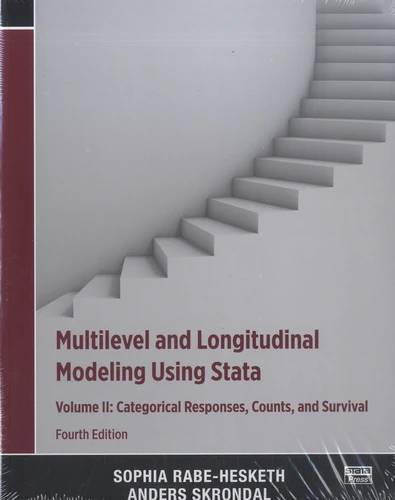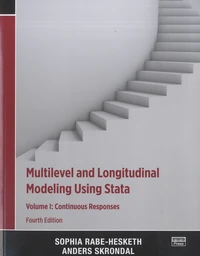Multilevel and Longitudinal Modeling Using Stata. Volume II : Categorical Responses, Counts, and Survival
4th edition
Par : , Formats :
- Paiement en ligne :
- Livraison à domicile ou en point Mondial Relay indisponible
- Retrait Click and Collect en magasin gratuit
- Nombre de pages544
- PrésentationBroché
- FormatGrand Format
- Poids1.19 kg
- Dimensions18,5 cm × 23,5 cm × 3,5 cm
- ISBN978-1-59718-138-9
- EAN9781597181389
- Date de parution22/10/2021
- ÉditeurStata Press
Résumé
Multilevel and Longitudinal Modeling Using Stata, Fourth Edition discusses regression modeling of clustered or hierarchical data, such as data on students nested in schools, patients in hospitals, or employees in firms. Longitudinal data are also clustered with, for instance, repeated measurements on patients or several panel waves per survey respondent. Multilevel and longitudinal modeling can exploit the richness of such data and can disentangle processes operating at different levels.
Assuming some knowledge of linear regression, this bestseller explains models and their assumptions, applies methods to real data using Stata, and shows how to interpret the results. Across volumes, the 16 chapters, over 140 exercises, and over 110 datasets span a wide range of disciplines, making the book suitable for courses in the medical, social, and behavioral sciences and in applied statistics.
Following volume I on models for continuous responses, this second volume covers models for all other important response types (binary, ordinal, nominal/discrete choice, counts, discrete-time and continuous-time survival/durations). It has been thoroughly revised and updated. New material includes Bayesian estimation for crossed-effects models and extensive use of several new commands (since the third edition), including meologit, cmxtmixlogit, mestreg, and menbreg.
Assuming some knowledge of linear regression, this bestseller explains models and their assumptions, applies methods to real data using Stata, and shows how to interpret the results. Across volumes, the 16 chapters, over 140 exercises, and over 110 datasets span a wide range of disciplines, making the book suitable for courses in the medical, social, and behavioral sciences and in applied statistics.
Following volume I on models for continuous responses, this second volume covers models for all other important response types (binary, ordinal, nominal/discrete choice, counts, discrete-time and continuous-time survival/durations). It has been thoroughly revised and updated. New material includes Bayesian estimation for crossed-effects models and extensive use of several new commands (since the third edition), including meologit, cmxtmixlogit, mestreg, and menbreg.
Multilevel and Longitudinal Modeling Using Stata, Fourth Edition discusses regression modeling of clustered or hierarchical data, such as data on students nested in schools, patients in hospitals, or employees in firms. Longitudinal data are also clustered with, for instance, repeated measurements on patients or several panel waves per survey respondent. Multilevel and longitudinal modeling can exploit the richness of such data and can disentangle processes operating at different levels.
Assuming some knowledge of linear regression, this bestseller explains models and their assumptions, applies methods to real data using Stata, and shows how to interpret the results. Across volumes, the 16 chapters, over 140 exercises, and over 110 datasets span a wide range of disciplines, making the book suitable for courses in the medical, social, and behavioral sciences and in applied statistics.
Following volume I on models for continuous responses, this second volume covers models for all other important response types (binary, ordinal, nominal/discrete choice, counts, discrete-time and continuous-time survival/durations). It has been thoroughly revised and updated. New material includes Bayesian estimation for crossed-effects models and extensive use of several new commands (since the third edition), including meologit, cmxtmixlogit, mestreg, and menbreg.
Assuming some knowledge of linear regression, this bestseller explains models and their assumptions, applies methods to real data using Stata, and shows how to interpret the results. Across volumes, the 16 chapters, over 140 exercises, and over 110 datasets span a wide range of disciplines, making the book suitable for courses in the medical, social, and behavioral sciences and in applied statistics.
Following volume I on models for continuous responses, this second volume covers models for all other important response types (binary, ordinal, nominal/discrete choice, counts, discrete-time and continuous-time survival/durations). It has been thoroughly revised and updated. New material includes Bayesian estimation for crossed-effects models and extensive use of several new commands (since the third edition), including meologit, cmxtmixlogit, mestreg, and menbreg.



